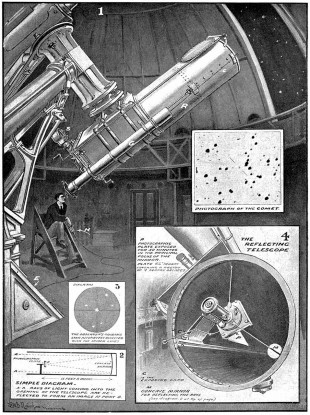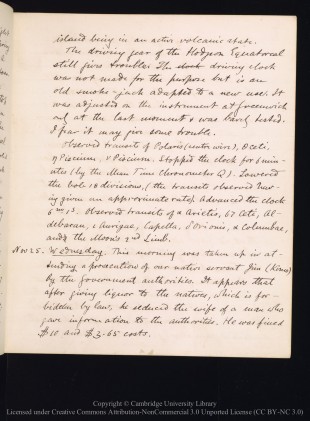…where east meets west
- Home
- Brief History
- The Greenwich Meridian
- Greenwich
(1675–1958) - Herstmonceux
(1948–1990) - Cambridge
(1990–1998) - Outstations (1822–1971)…
- – Chingford (1822–1924)
- – Deal
(1864–1927) - – Abinger
(1923–1957) - – Bristol & Bradford on Avon
(1939–1948) - – Bath
(1939–1949) - – Hartland
(1955–1967) - – Cape of Good Hope
(1959–1971)
- Administration…
- – Funding
- – Governance
- – Inventories
- – Pay
- – Regulations
- – Royal Warrants
- Contemporary Accounts
- People
- Publications
- Science
- Technology
- Telescopes
- Chronometers
- Clocks & Time
- Board of Longitude
- Libraries & Archives
- Visit
- Search
Telescope: Hodgson Equatorial

Charles Davidson at the eyepiece of the Hodgson guiding telescope (G) of the 30-inch Reflector (R) during the photographic search for Halley's Comet in September 1909. An electric key (H) in his hand allowed him to finely adjust he rate of the driving clock (E). The exposing cord is marked (C) and the spectroscope, which is not in use, (S). Later copy of an illustration originally published in the 16 October 1909 edition of The Illustrated London News
In the introductions to Greenwich Observations for all the years from 1898–1909 the focal length of the Hodgson is consistently given by the Astronomer Royal, William Christie, as 7 feet 7 inches (91 inches). This figure however is contradicted by measurements made in 2016 which indicate a focal length of just 88.5 inches and a diameter for the Object Glass of about 6.25 inches.
Early history
Believed to have been acquired by Hodgson in 1852, the telescope was originally set up by him in a newly built observatory at his then home at Claybury in Essex. It was later moved to his new house, Hawkwood, in Chingford. Demolished in 1944 following war damage, Hawkwood was located more or less on the Greenwich Meridian, about half a kilometre to the north of the Chingford Obelisk which had been erected by the Astonomer Royal, John Pond, in 1824 to aid with the alignment of the Troughton 10-foot Transit Instrument.
The Transit of Venus expeditions
The British set up five Stations across the globe from which to observe the 1874 Transit. The Hodgson Equatorial was one of the instruments sent to the Sandwich Islands (Station B) where it was used on the island of Kailua by George Forbes. In the published write up of the expedition (link below), the instrument and its set up is described as follows (note the very different focal length that is quoted):

In this page from the journal kept by George Forbes during the 1874 Transit, he gives details of the problem with the telescope's drive (a smoke-jack is a device for turning a roasting spit, set in motion by the current of ascending gases in a chimney). In an earlier entry (18 Nov), he records how the carpenter had had to extemporise a handle for controlling the slow motion in declination as the proper one appeared not to have been packed. Reproduced courtesy of Cambridge Digital Library (see below)
‘The object-glass, supposed to be by Cauchoix, was six inches in diameter, but the effective aperture was 5.7 inches, and the focal length was 75 inches. Professor Forbes describes its defining power as admirable.
At Kailua the long polar axis was supported by a massive framework of timber, which had been constructed at Greenwich, and adapted very nearly to the requisite latitude. The instrument was used in the open air, and when out of use was protected by a large tarpaulin.
The double-image-micrometer and solar diagonal reflector were made by Messrs. Troughton and Simms; the former was kindly lent to the Astronomer Royal by J.G. Barclay, Esq., of Leyton, Essex.’
‘The driving clock [...] was a very imperfect arrangement. It was so irregular in its action (after all care had been taken to make its parts work easily) that it was necessary to have some one well fitted for the work to accelerate or retard the motion slightly, and gently, and to re-connect the clock-work. Mr. Bigge accomplished this admirably. He also attended to the sunshade, clamps, &c.’
Together with many of the other Transit of Venus instruments, including all five of the other 6-inch equatorials, the Hodgson was formally transferred to the Royal Observatory in 1876. The telescope was subsequently shipped to Barbados for the 1882 Transit of Venus which took place on 6 December. It was returned to Greenwich (minus the timber stands for the polar axis) on 3 February 1883 (RGO6/283/461).
Later use as a sighting telescope
In 1883/4, the object glass was lent to the Experimental Light Committee of the Trinity House where it was used for photometric experiments (probably the trials that took place at South Foreland during 1884 and 1885 to determine the relative value of the electric, gas, and oil lights as illuminants for lighthouses (see RGO7/69 for details of the loan). It was returned in the year 1887/8. In September 1898 (RGO39/10/94), the Hodgson was mounted on the newly commissioned Thompson 30-inch Reflector as a guiding telescope on which instrument it can still be seen today at Herstmonceux.
Contemporary accounts and further reading
Transit of Venus, 1882. Report of the Committee appointed by the British government to superintend thearrangements to be made for the sending of expeditions at the government expense, and securing co-operation with the government expeditions for the observation of the Transit of Venus, 1882, December 6, (HMSO, 1887)
Image Licensing
The image of the page from the Transit of Venus Journal of George Forbes is reproduced in compressed and slightly cropped form under the terms of a Creative Commons Attribution-NonCommercial 3.0 Unported License courtesy of Cambridge Digital Library (RGO59/69).
© 2014 – 2025 Graham Dolan
Except where indicated, all text and images are the copyright of Graham Dolan